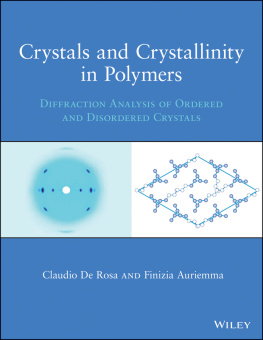Introduction
Synthetic chemistry provides an economic way to produce polymers with the same monomer units and regular sequence structures, both of which favor crystallization. However, a polymer with fully crystalline structure has only hard and brittle properties, which limit its practical application. Introducing intramolecular defects, mainly on the backbone chain, is the conventional path for obtaining a useful semicrystalline product. Sequence irregularities on the backbone can be classified according to three sources in the detailed polymerization processes: chemical modifications, geometric isomers, and stereoisomers. For instance, various kinds of chemical modifications on the backbone have led to important new classes of commercial polyolefins, such as high impact polypropylene (HIPP), high density polyethylene (HDPE), low density polyethylene (LDPE), heterogeneous and homogeneous linear low density polyethylene (LLDPE), and very low density polyethylene (VLDPE).
Over the years, every part of the chain of knowledge for polymer crystallization (meaning the successive steps from polymerization via processing to properties) has been well studied, but the links between these parts are still weak or even absent []. For instance, studies of the connection between chain microstructure and crystallization behavior often stopped at the content of sequence defects and overlooked their detailed distribution, probably as a result of technical difficulties in obtaining a clear characterization of sequence distribution. However, defect distribution has a huge impact on the crystallization behavior of polymers, which is why determination of the distribution should have the full attention of researchers studying the crystallizability of polymers, especially because crystallization has appreciable effects on the end properties of the product. During crystallization, the sequence segments containing defects do not usually match the geometric or spatial requirements of compact packing in the crystalline ordered regions composed of crystallizable units. Thus, they behave like noncrystallizable entities and hinder the development of crystallinity by the polymer main chains. In this sense, they bring an intramolecular chemical confinement, being inclusion in the case of mobile defects or exclusion in the case of immobile defects in the crystalline phase, which depends on the size and rigidity of the defect-containing segments relative to the crystallizable units. The sequence defects, on the one hand, bring more chain connections between crystallites to improve the durability of plastic products, but, on the other hand, suppress crystallinity and in extreme cases give rise to an amorphous polymer such as atactic polystyrene or atactic poly(methyl methacrylate) (PMMA). Driven by strong industrial interests, along with modern developments in the use of well-designed catalysts, NMR characterization, and molecular simulations, research has stepped forward to examine how the detailed distribution of sequence defects affects crystallization behavior and the resulting semicrystalline structure of synthetic polymers.
Many synthetic polymers show sequence defect distributions that resemble some statistical features; therefore, their crystallization behaviors can be discussed by treating them as statistical copolymers produced by typical addition polymerization following a statistical mechanism. Statistical homogeneous and heterogeneous copolymers, although distinguished by their differing homogeneity of comonomer distribution among macromolecules, both exhibit an intramolecular multicomponent behavior. Upon crystallization, two levels of component microphase segregation (from small to large scale) may be of relevance: monomer segregation (according to different chemical species of the chain units) and monomer-sequence segregation (according to different consecutive lengths of monomer units along the chain). Heterogeneous copolymers have, in addition, an intermolecular multicomponent phase-separation behavior (caused by different comonomer contents and distributions between macromolecules), which could lead to macromolecular segregation. Various levels of liquidliquid phase separation are likely to occur prior to liquidsolid crystallization and, thus, change the course of the latter. Therefore, the interplay between crystallization and component segregation is an interesting issue [] and of importance in understanding better the complex phase transition behavior of statistical copolymers.
In this review, we survey current understanding of different levels of component segregation and the resulting crystallization phenomena of statistical copolymers. After a description of statistical copolymers, the discussion focuses on the occurrence of monomer segregation, monomer-sequence segregation, and macromolecular segregation during the process of crystallization of statistical copolymers. For each type of segregation, we discuss factors of chemical structure such as comonomer content, comonomer distribution, and molar mass, as well as the thermodynamic conditions (mainly temperature). More specifically, we compare various copolymers of different comonomer mobility in the crystalline phase, which represent different extents of intramolecular confinement in the crystallization of statistical copolymers. We hope that with this strategy, the complex crystallization behavior of statistical copolymers can clearly unfold in front of the readers eyes.












